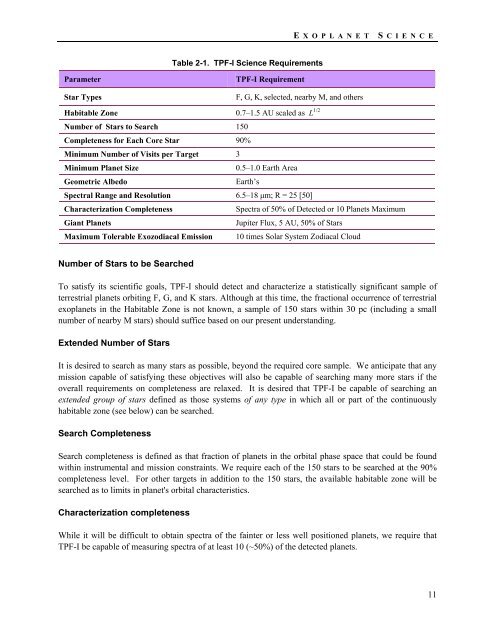TPF-I SWG Report - Exoplanet Exploration Program - NASA
TPF-I SWG Report - Exoplanet Exploration Program - NASA
TPF-I SWG Report - Exoplanet Exploration Program - NASA
Create successful ePaper yourself
Turn your PDF publications into a flip-book with our unique Google optimized e-Paper software.
E X O P L A N E T S CIENCE<br />
Table 2-1. <strong>TPF</strong>-I Science Requirements<br />
Parameter<br />
<strong>TPF</strong>-I Requirement<br />
Star Types<br />
F, G, K, selected, nearby M, and others<br />
Habitable Zone 0.7–1.5 AU scaled as L 1/2<br />
Number of Stars to Search 150<br />
Completeness for Each Core Star 90%<br />
Minimum Number of Visits per Target 3<br />
Minimum Planet Size<br />
0.5–1.0 Earth Area<br />
Geometric Albedo<br />
Earth’s<br />
Spectral Range and Resolution 6.5–18 μm; R = 25 [50]<br />
Characterization Completeness<br />
Spectra of 50% of Detected or 10 Planets Maximum<br />
Giant Planets<br />
Jupiter Flux, 5 AU, 50% of Stars<br />
Maximum Tolerable Exozodiacal Emission 10 times Solar System Zodiacal Cloud<br />
Number of Stars to be Searched<br />
To satisfy its scientific goals, <strong>TPF</strong>-I should detect and characterize a statistically significant sample of<br />
terrestrial planets orbiting F, G, and K stars. Although at this time, the fractional occurrence of terrestrial<br />
exoplanets in the Habitable Zone is not known, a sample of 150 stars within 30 pc (including a small<br />
number of nearby M stars) should suffice based on our present understanding.<br />
Extended Number of Stars<br />
It is desired to search as many stars as possible, beyond the required core sample. We anticipate that any<br />
mission capable of satisfying these objectives will also be capable of searching many more stars if the<br />
overall requirements on completeness are relaxed. It is desired that <strong>TPF</strong>-I be capable of searching an<br />
extended group of stars defined as those systems of any type in which all or part of the continuously<br />
habitable zone (see below) can be searched.<br />
Search Completeness<br />
Search completeness is defined as that fraction of planets in the orbital phase space that could be found<br />
within instrumental and mission constraints. We require each of the 150 stars to be searched at the 90%<br />
completeness level. For other targets in addition to the 150 stars, the available habitable zone will be<br />
searched as to limits in planet's orbital characteristics.<br />
Characterization completeness<br />
While it will be difficult to obtain spectra of the fainter or less well positioned planets, we require that<br />
<strong>TPF</strong>-I be capable of measuring spectra of at least 10 (~50%) of the detected planets.<br />
11
















